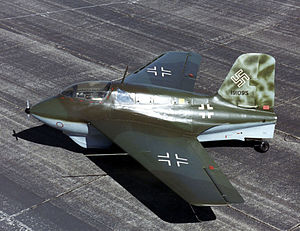
Back Messerschmitt Me 163 Komet Afrikaans Messerschmitt Me 163 AN مسرشميت مي 163 Arabic Messerschmitt Me 163 Azerbaijani Месершмит 163 Bulgarian Messerschmitt Me 163 Catalan Messerschmitt Me 163 Czech Messerschmitt Me 163 Danish Messerschmitt Me 163 German Messerschmitt Me 163 Greek
| Me 163 Komet | |
|---|---|

| |
| Me 163B on display at the National Museum of the United States Air Force[N 1] | |
| Role | Interceptor |
| National origin | Germany |
| Manufacturer | Messerschmitt |
| Designer | Alexander Lippisch |
| First flight | 1 September 1941 |
| Introduction | 1944 |
| Primary user | Luftwaffe |
| Number built | ~370[1][2] |
| Developed into | Messerschmitt Me 263 |
The Messerschmitt Me 163 Komet is a rocket-powered interceptor aircraft primarily designed and produced by the German aircraft manufacturer Messerschmitt. It is the only operational rocket-powered fighter aircraft in history as well as the first piloted aircraft of any type to exceed 1,000 kilometres per hour (620 mph) in level flight.
Development of what would become the Me 163 can be traced back to 1937 and the work of the German aeronautical engineer Alexander Lippisch and the Deutsche Forschungsanstalt für Segelflug (DFS). Initially an experimental programme that drew upon traditional glider designs while integrating various new innovations such as the rocket engine, the development ran into organisational issues until Lippisch and his team were transferred to Messerschmitt in January 1939. Plans for a propeller-powered intermediary aircraft were quickly dropped in favour of proceeding directly to rocket propulsion. On 1 September 1941, the prototype performed its maiden flight, quickly demonstrating its unprecedented performance and the qualities of its design. Having been suitably impressed, German officials quickly enacted plans that aimed for the widespread introduction of Me 163 point-defence interceptors across Germany. During December 1941, work began on the upgraded Me 163B, which was optimized for large-scale production.
During early July 1944, German test pilot Heini Dittmar reached 1,130 km/h (700 mph), an unofficial flight airspeed record that remained unmatched by turbojet-powered aircraft until 1953. That same year, the Me 163 began flying operational missions, being typically used to defend against incoming enemy bombing raids. As part of their alliance with Empire of Japan, Germany provided design schematics and a single Me 163 to the country; this led to the development of the Mitsubishi J8M. By the end of the conflict, roughly 370 Komets had been completed, most of which were being used operationally. Some of the aircraft's shortcomings were never addressed, and it was less effective in combat than predicted. Capable of a maximum of 7.5 minutes of powered flight, its range fell short of projections and greatly limited its potential. Efforts to improve the aircraft were made (most notably the development of the Messerschmitt Me 263), but many of these did not see actual combat due to the sustained advancement of the Allied powers into Germany in 1945.
After being introduced into service the Me 163 was credited with the destruction of between 9 and 18 Allied aircraft against 10 losses.[3][4] Aside from the actual combat losses incurred, numerous Me 163 pilots had been killed during testing and training flights.[5][page needed] This high loss rate was, at least partially, a result of the later models' use of rocket propellant, which was not only highly volatile but also corrosive and hazardous to humans.[6] One noteworthy fatality was that of Josef Pöhs, a German fighter ace and Oberleutnant in the Luftwaffe, who was killed in 1943 through exposure to T-Stoff in combination with injuries sustained during a failed takeoff that ruptured a fuel line.[7][page needed] Besides Nazi Germany, no nation ever made operational use of the Me 163; the only other operational rocket-powered aircraft was the Japanese Yokosuka MXY-7 Ohka which was a manned flying bomb.
Cite error: There are <ref group=N> tags on this page, but the references will not show without a {{reflist|group=N}} template (see the help page).
© MMXXIII Rich X Search. We shall prevail. All rights reserved. Rich X Search